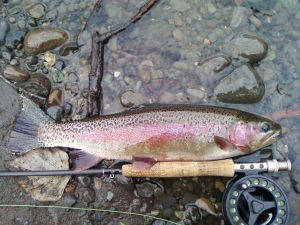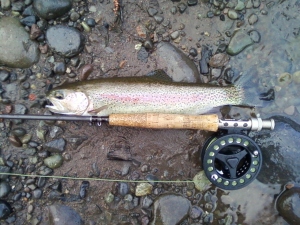As discussed in the previous post “Is You Is or Is You Ain’t?” https://flyfishingnut.wordpress.com/2010/02/02/is-you-is-or-is-you-aint/, we discovered that steelhead are nothing more than anadromous (ocean going) rainbow trout. Also, in another post, it was discussed that steelhead, like their potamodromous counterparts, prefer much the same waters, flows, and redds. So, wouldn’t it stand that these elusive fish, really aren’t THAT elusive, and once in a river system, they may revert back to their “trouty” ways? Personally, I think they do, and here’s why.
February 14, 2010. As we all know this is Cupid’s day. Along with it being Valentine’s Day, it also marks the high point, or so I’m told, of the winter steelhead season. This particular day also happened to coincide with a new moon. Which just happened to turn out to be the best day of steelhead fishing, or just about any fishing I’ve ever encountered. Coincidence? Maybe, but I tend to lean more towards the perfect storm.
The day was not a typical Valentine’s day, the weather was mild, cloudy, and the river was on a slow fall. There hadn’t been a ton of rain, so the river was already lower than normal and pretty clear. I had gotten a late start on this particular morning, because Mrs. Monster and I had decided to get a Valentine’s breakfast at the Ye Olde Pancake House here in Eugene. We took the kids out with us and made it a family outing. After getting back home, I hopped in the fishmobile and off to the river I went. After an hour drive, I arrived at my fishing hole for the day. I jumped out of the car, suited up, strung up the Scott 8wt (that was given to me as a Christmas present by Chuckster). Tied on a #6 possie bugger that I had tied the night before, and off down to my spot on the bank. It was around 11:00am when I started fishing.
To my surprise, there weren’t many people out fishing the bank that day. Several of the regulars and one or two new faces were passing in and out of the popular fishing hole. Maybe 20 or 30 minutes of fishing, and I called out “fish on!” To the bank, came a nice and fairly bright hatchery hen that was about 7 lbs. I gave the hen away to an aspiring fisherwoman, we’ll call her Wilma (not her real name). Wilma was super excited about the fish, and I had kept one the day before, so no need for another fish at least not this day.
Back to my fishing hole, and it wasn’t too much longer, before the cry of “fish on” was heard down the bank again. This time, a solid tug followed by a huge head-shake was felt through the graphite in my fly rod. I knew there was a fairly large fish at the other end. After a good solid hook-set and getting the fish on the reel, it wasn’t long before a rather large and very brightly chromed fish jumped about 4′ out of the water. Upon which my 3x (9.2lb) Seaguar Flourocarbon tippet snapped like a twig from a dead tree. Fish off! Wow what a show. A big chrome steelhead jumping like that. It was an impressive display.
There were 3 other times that I could have given the “fish on” war cry, but would have been cut very short because the fish pulled loose, or the hook didn’t get a good set. And at least 2 times I just failed to set the hook and just watched dumbfounded as my thingamabobber took the “Nestea Plunge”.
Moving forward to later that afternoon, one of the regulars, we’ll call him Elkman (not his real name) showed back up. Elkman landed a monster hatchery buck the following day, that was @ 15 lbs or better that measured out at 35″, but was really dark. Elkman released him. Anyway, Elkman showed up and came over to talk. I informed him that I was having just a stellar day and recanted all of the fish I’d had on, or missed. He looked at me and said, “Well, it’s about damn time!” I laughed and agreed with him, said something to the effect of,”Now, there’s an understatement.” Being my ninth trip this year without a fish, the discouragement had just about started to set in.
While Elkman and I were talking, I hooked and lost my 8th of the day. Slightly disappointed, but also excited, Elkman and I begin a conversation about setting the hook. It wasn’t long, maybe 2 casts later and “fish on!” And again, just like the one before, a BIG bright chrome steelhead comes lurching out of the water the the height of about 4′. Feeling pretty confident, I had set the hook in this one very soundly, but upon it landing back in the water, my line comes flying back at me. Broken off again!… ARGH!
I re-tie my entire leader. Using a non-conventional leader, makes it quicker and a bit easier to replace. One perfection loop and then a palomar to my fly. Easy enough. I get re-rigged, and Elkman says. I bet there’s one more in there. To which I agreed and the very next cast…
A rather large hatchery buck @ 10lbs grabs my fly and it was game on. I finally landed him and released him. Yes, I know I should remove all hatchery fish, and it is a good way to clean up the rivers. But, by this time, most everybody was gone for the day, and nobody wanted him, least of all me. He was pretty gnarly, he was colored up like a rainbow, and had several white patches on his nose and other places. Back in the river he went.
As I counted 10 possible fish. 4 of which I actually had on the hook for at least a few seconds and was sure they were steelhead, because I either saw them or they put a huge bend in my 8wt. 2 of which I just straight up missed and didn’t even bother setting the hook because I was too shocked to see my indicator plunge underwater. 2 steelhead landed, and another 2 that broke off after a great aerial display. All fish were caught on a #6 (slightly sized up) possie bugger. Which just further proves my theory that steelhead can and will act very trout-like.
So went the best day of fly fishing for chrome I’ve had to date. And quite possibly one of the best days of fishing that I’ve ever had. A day like this fishing for Winter Steelhead isn’t very common. This sort of thing just happens to the most accomplished of anglers. I’m no accomplished angler. I was just terribly lucky. I was in the right place, at the right time, and the perfect storm was in full swing.
Good luck
Practice catch and release, and clean up the rivers. Catch all the hatchery fish you can and release them somewhere other than back in the river they came from!
Until next time!
Dave




